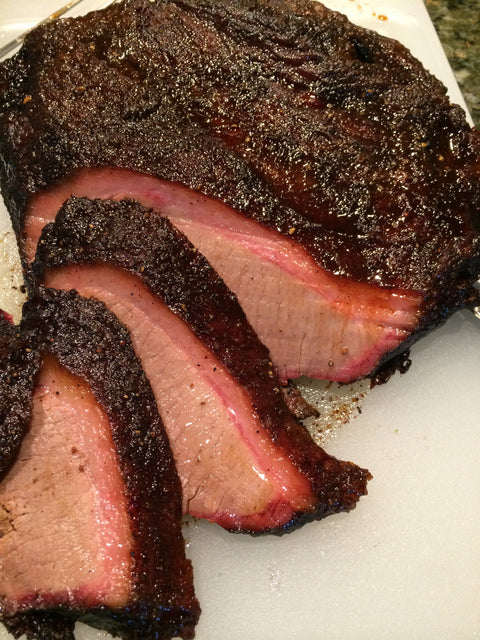
A picture of a smoked section of a brisket showing the 'flat' and the 'point'
The Art of Brisket: A Culinary Journey Through Smoke, Flavor, and Tradition
The Basics: Brisket - it's not just a cut of meat; it's a culinary tradition, a symbol of patience, skill, and flavor. Whether you're a seasoned pitmaster or a curious food enthusiast, the journey through the world of brisket is as rich and varied as the flavors it encompasses. Join me as we explore the art of brisket, from its humble beginnings to the mouthwatering dishes it inspires. Typically, a "full-packer" brisket contains two muscles, often referred to as the "point" and the "flat". The Point is thicker and contains more fat, and the flat is thinner and is leaner.
Where it comes from: The Brisket is sourced from the breast section of the cow, below the first five ribs, and is commonly used for smoking, braising, or barbecuing.
The Origin Story: To truly appreciate brisket, we must delve into its origins. Historically, brisket was a cut of meat often overlooked, deemed tough and undesirable. However, in the hands of skilled cooks, particularly in Texas, brisket underwent a transformation. Through slow cooking methods such as smoking and braising, brisket became tender, flavorful, and utterly irresistible.
The Process: Central to the allure of brisket is the process of cooking it. It's a labor of love, requiring patience, attention to detail, and a deep understanding of the meat. Traditionalists swear by the low and slow method, where the brisket is smoked over hardwood for 12 hours or more. This process allows the meat to tenderize slowly, while absorbing the smoky essence of the wood.
However, there are countless variations and techniques employed by cooks around the world. From the use of different wood varieties for smoking to the incorporation of unique spice rubs and marinades, each pitmaster puts their own spin on the timeless art of brisket preparation.
The Flavor Profile: One of the most enticing aspects of brisket is its flavor profile. When cooked to perfection, brisket boasts a harmonious balance of smokiness, richness, and tenderness. The outer bark, formed by the caramelization of spices and rendered fat during the smoking process, provides a tantalizing contrast to the succulent meat within.
Furthermore, brisket is incredibly versatile, lending itself to a myriad of flavor combinations and culinary creations. Whether served simply sliced with a side of tangy barbecue sauce or incorporated into tacos, sandwiches, or even chili, brisket never fails to delight the taste buds.
The Cultural Significance: Beyond its culinary merits, brisket holds a special place in the hearts and traditions of various cultures. In Texas, brisket is practically a religion, with barbecue joints serving as revered institutions and pitmasters as local heroes. Similarly, in Jewish cuisine, brisket takes center stage during holidays and celebrations, cooked low and slow until fork-tender and bathed in a savory gravy.
Moreover, brisket has transcended geographical and cultural boundaries, finding its way onto menus and dinner tables across the globe. Its universal appeal speaks to the power of food to unite people and bridge cultural divides.
To wrap or not to wrap smoked Brisket: See our blog post about wrapping brisket, to see if you should wrap brisket, and if so what should you wrap it, for how long, and when to start wrapping your Brisket!
Conclusion: In conclusion, brisket is more than just a cut of meat - it's a culinary journey steeped in tradition, flavor, and community. Whether you're a novice cook eager to try your hand at smoking your first brisket or a seasoned aficionado seeking to perfect your craft, there's always something new to discover and savor in the world of brisket. So fire up the smoker, gather your friends and family, and prepare to embark on an unforgettable gastronomic adventure. After all, when it comes to brisket, the journey is just as rewarding as the destination.


